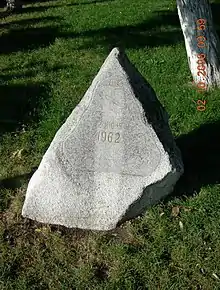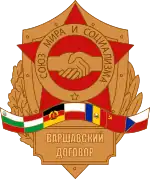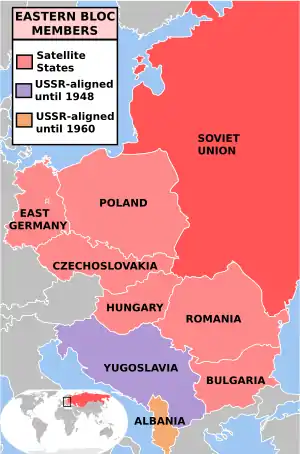Novocherkassk massacre
The Novocherkassk massacre (Russian: Новочеркасский расстрел, romanized: Novocherkasskiy rasstrel) was a massacre committed against unarmed protesters on June 2, 1962 in the Russian city of Novocherkassk by the Soviet army and KGB officials.[1] A few weeks earlier workers organised a labor strike at the Novocherkassk Electromotive (Electric Locomotive) Building Factory (NEBF).
| Novocherkassk massacre Новочеркасский расстрел | |
|---|---|
 Tombstone to the victims of the massacre, also known as "Stone on Blood". The writing reads: "2 June 1962". | |
| Location | Novocherkassk, Rostov Oblast, Russian SFSR, Soviet Union |
| Date | June 2, 1962 |
Attack type | Shooting |
| Weapons | Sniper rifles, machine guns, APCs, cars, tanks |
| Deaths | 26 |
| Perpetrators | Soviet Army, KGB |
| Motive | Quelling protests |
The strike was caused by discontent over an increase of production quotas coinciding with a nationwide increase in dairy and meat prices.[2] The events spurred into a mass protest at the administration building in the center of the city where armed forces dispersed protesters by gunfire. According to official investigation 26 were reportedly killed by troops, and 87 were wounded.[3] According to Aleksandr Solzhenitsyn's The Gulag Archipelago (page 449 in the abridged version), "Information from a variety of sources is more or less unanimous that some seventy or eighty people were killed".
Arrests, show trials and cover-ups ensued: more than 200 were arrested; seven people were convicted and sentenced to death over various "crimes" such as "mass disorder" and approximately hundreds of others were imprisoned up to 15 years (terms of some of which were later reduced);[4] news about events never appeared in state controlled press and held secret up until 1992.[5][6] The 26 dead were secretly buried by KGB operatives in false graves which were never disclosed to relatives until June 2, 1994 when all bodies were discovered and reburied at the official memorial.
In 1992, shortly after the Soviet Union's collapse, the events were investigated by General Prosecutor. Major suspects among the highest soviet officials such as Nikita Khrushchev, Anastas Mikoyan, Frol Kozlov and several others who were deemed responsible for the massacre were never held accountable due to their deaths by the time the investigation has started.[7][8] The fate of others as of 2019 remains unknown. The massacre is commemorated each year on the anniversary of the murders by a group of surviving participants of the protests.
| Eastern Bloc |
|---|
 |
Timeline
May
- May 1-7: According to V. A. Kozlov, the first signs of discontent among workers were expressed long before the massacre happened. The first isolated cases of individual strikes at the NEBF were recorded. It was claimed that among the strikers were many experienced political prisoners who were previously repressed by the Soviet regime, but this is not supported by any evidence.[9][10]
- May 17: The Council of Ministers issued decree No. 456, which declared a nationwide increase in the price of various items planned to come into effect on June 1.[11][note 1]
- May 31: The first news of the No. 456 decree appeared in the Soviet press.[12][note 1]
June
- June 1: The protests grew. At this time the strikers were harassed by Soviet army personnel, soviet militsiya with various clashes between them and the protesters, who attempted to spark strikes in other factories around NEBF.
- June 2: The strike over the NEBF continued overnight. In the early morning thousands marched from NEBF toward Novocherkassk's centre carrying portraits of Lenin and red flags; they were heading toward buildings of the city's council and executive committee;[13] though disorganised at this point the crowd was calm and peaceful. The crowd crossed the bridge spanning the Tuzlov river and was met by tanks commanded by Colonel Matvey Shaposhnikov who refused to open fire at the people; at the time many members of the CC of the CPSU, KGB, MIA and other high officials had already arrived and were present in the city. By the time the crowd reached the centre of the city authorities learned that they had passed the bridge unopposed - consequently deciding to quickly retreat into safety. As the march continued to advance toward the centre, more people started to join crowd, frightening the authorities further. The crowd attacked and looted several administrative buildings and police stations, sparking brief violence; demands to Mikoyan to come out and speak to people followed. At midday the army attempted to disperse the crowd using soldiers and armoured personnel carriers but failed and shortly after fired at the people, claiming the lives of 22 and wounding many others, including soldiers.[14] On the evening of the same day, two protesters were killed according to officials.
- June 2-3: A curfew was imposed and lasted more than a week;[note 2] Protests continued though at smaller scale.
July
- July 19: Some of the protesters were sentenced to ten years in prison.[15]
October
- October 19: A report about rumours of the massacre appeared in Time Magazine.[16]
History
The riots were a direct result of shortages of food and provisions, as well as the poor working conditions in the factory. The protest began on June 1 in the Budyonny Electric Locomotive Factory, when workers from the foundry and forge shops stopped work after factory management refused to hear their complaints. The strike and attendant discussions had spread throughout the whole factory by noon.
The unrest began when Nikita Khrushchev raised the prices of meat and butter throughout the Soviet Union on June 1. On the same day, as required by a separate economic plan, the minimum production quotas for each worker at the factory were increased,[17] thereby effectively reducing pay rates.[18] This culminated in a march on the town hall and police headquarters, and the strike spread to other enterprises after police arrested thirty workers.
According to documents declassified in 90's, motorised infantry units were called to suppress the protesters, but they fired in the air, and the lethal fire came from a unit of Internal troops, from Rostov-on-Don composed of 10 snipers and 2 machine guns, who were set up at the "Don" hotel. Orders to kill were approved through the whole chain of command, from Khrushchev, through the ministry of defense.[19]
The Commander of the North-Caucasian Troops, general Matvey Kuzmich Shapochnikov, refused to execute an order to attack peaceful demonstrators with tanks (he reportedly said, "I don't see any enemy that we could turn our weapons against"), for which he was later degraded and arrested.[20]


Victims
According to now available official sources, 26 protesters were machine-gunned and killed by Soviet troops.[21][22] An additional 87 protesters were wounded, three of them mortally. Due to Soviet propaganda at that time the protesters trusted the Soviet army, and many did not expect them to fire live ammunition at unarmed citizens.[23] After the initial demonstrations a curfew was imposed on the city. The dead were secretly buried in cemeteries scattered across the Rostov Oblast. However, the following morning a group of several hundred demonstrators again gathered in the square. One hundred sixteen were arrested, and fourteen were convicted in show trials. Seven of those convicted received a death sentence. The others were sentenced to prison terms of ten to fifteen years.[4]
Following the incident, the Soviet government directed extra food supplies to the region and began an investigation. Additional workers were arrested, and several military officials involved in the incident were court martialed. Aleksandr Solzhenitsyn claimed that other individuals wounded in the unrest and their families were exiled to Siberia.
The story was hushed-up by Soviet media and remained an official secret until 1992, a year after the fall of the Soviet Union. At that time the remains of 20 protesters were recovered, identified, and buried in the Novoshakhtinsk cemetery.
In fiction
During a Politburo scene in The Devil's Alternative (1979) by author Frederick Forsyth, the KGB chief, asked if he could suppress riots during famine, responds that the KGB could suppress ten, even twenty Novocherkassks, but not fifty – intentionally using the example to highlight how serious the difficulties would be that the Soviet Union finds itself in the novel.
The massacre is dramatised in Francis Spufford's 2010 novel Red Plenty.
Films Once upon a time in Rostov (2012) and Dear Comrades (2020) offer depictions of the massacre.
Notes
- Here it is listed for reference as it was mentioned in the source book.[9]
- though sources differ on when and how long exactly.
References
- 1961: Novocherkassk Massacre Archived 2011-03-03 at the Wayback Machine
- "Novocherkassk Massacre". Seventeen Moments in Soviet History. 2015-06-19. Retrieved 2019-06-02.
- "Не хватает денег на мясо и колбасу, ешьте пирожки с ливером". Бессмертный барак. Retrieved 2016-06-02.
- Taubman, William. Khrushchev: The Man and His Era, First Edition, W. W. Norton & Co., New York, NY. 2003.
- "MASSACRE IN WORKERS PARADISE". Washington Post. 1990-12-18. ISSN 0190-8286. Retrieved 2019-06-02.
- Kozlov, V. A. (Vladimir Aleksandrovich); Козлов, В. А. (Владимир Александрович) (2005). "13". Neizvestnyĭ SSSR : protivostoi︠a︡nie naroda i vlasti, 1953-1985. Moskva: Olma Press. p. 390. ISBN 5224053579. OCLC 65428522.
- Би-би-си, Артем Кречетников; Москва. "Бойня в Новочеркасске: "Но был один, который не стрелял"". BBC News Русская служба (in Russian). Retrieved 2019-06-02.
В 1992 году Главная военная прокуратура возбудила по факту новочеркасского расстрела уголовное дело против Хрущева, Козлова, Микояна и еще восьми человек, которое было прекращено в связи с их смертью.
- Ростов, АиФ- (2017-06-02). "Новочеркасский расстрел: герои, палачи и жертвы трагедии 1962 года". www.rostov.aif.ru. Retrieved 2019-06-02.
- Kozlov, V. A. (Vladimir Aleksandrovich); Козлов, В. А. (Владимир Александрович) (2005). Neizvestnyĭ SSSR : protivostoi︠a︡nie naroda i vlasti, 1953-1985. Moskva: Olma Press. ISBN 5224053579. OCLC 65428522.
- Kozlov, V. A. (Vladimir Aleksandrovich); Козлов, В. А. (Владимир Александрович) (2005). "13". Neizvestnyĭ SSSR : protivostoi︠a︡nie naroda i vlasti, 1953-1985. Moskva: Olma Press. pp. 333, 334. ISBN 5224053579. OCLC 65428522.
- "СОВЕТ МИНИСТРОВ СССР ПОСТАНОВЛЕНИЕ от 17 мая 1962 г. N 456 О ПОВЫШЕНИИ ЗАКУПОЧНЫХ (СДАТОЧНЫХ) ЦЕН НА КРУПНЫЙ РОГАТЫЙ СКОТ, СВИНЕЙ, ОВЕЦ, ПТИЦУ, МАСЛО ЖИВОТНОЕ И СЛИВКИ И РОЗНИЧНЫХ ЦЕН НА МЯСО, МЯСНЫЕ ПРОДУКТЫ И МАСЛО ЖИВОТНОЕ".
- "События в г. Новочеркасске 1 мая 1962". histrf.ru (in Russian). Retrieved 2019-06-02.
- "MASSACRE IN WORKERS PARADISE". Washington Post. 1990-12-18. ISSN 0190-8286. Retrieved 2019-06-02.
On the morning of June 2 at around 11.00, 7,000 workers and other demonstrators began a protest march from the plant to the centre of Novocherkassk, simply ignoring troops and tanks that surrounded the plant. As they marched, some workers tried to block the railway line leading into town as a further show of protest.
- Kozlov, V. A. (Vladimir Aleksandrovich); Козлов, В. А. (Владимир Александрович) (2005). Neizvestnyĭ SSSR : protivostoi︠a︡nie naroda i vlasti, 1953-1985. Moskva: Olma Press. p. 370. ISBN 5224053579. OCLC 65428522.
- Kozlov, V. A. (Vladimir Aleksandrovich); Козлов, В. А. (Владимир Александрович) (2005). "13". Neizvestnyĭ SSSR : protivostoi︠a︡nie naroda i vlasti, 1953-1985. Moskva: Olma Press. p. 345. ISBN 5224053579. OCLC 65428522.
- "Russia: And Then the Police Fired". Time. 1962-10-19. ISSN 0040-781X. Retrieved 2019-06-02.
- Vladislav Zubok and Constantine Pleshkov, Inside the Kremlin's Cold War: from Stalin to Khrushchev, Harvard University Press, p. 262
- Hosking, Geoffrey. A History of the Soviet Union, Fontana Press, London. 1992.
- "Не хватает денег на мясо и колбасу, ешьте пирожки с ливером". Бессмертный барак. Retrieved 2018-06-04.
- "Шапошников Матвей Кузьмич - История на сайте Бессмертный барак". Шапошников Матвей Кузьмич :: Бессмертный барак. Retrieved 2018-06-04.
- (in Russian) Новочеркасск вспоминает жертв трагедии, Vest, 2007
- And Then the Police Fired, TIME Magazine, October 19, 1962
- Kozlov, V. A. (Vladimir Aleksandrovich); Козлов, В. А. (Владимир Александрович) (2005). "13". Neizvestnyĭ SSSR : protivostoi︠a︡nie naroda i vlasti, 1953-1985. Moskva: Olma Press. p. 335. ISBN 5224053579. OCLC 65428522.
External links
- The Novocherkassk Tragedy, June 1–3 1962 – An eyewitness account of the strike leading up to the shootings.
